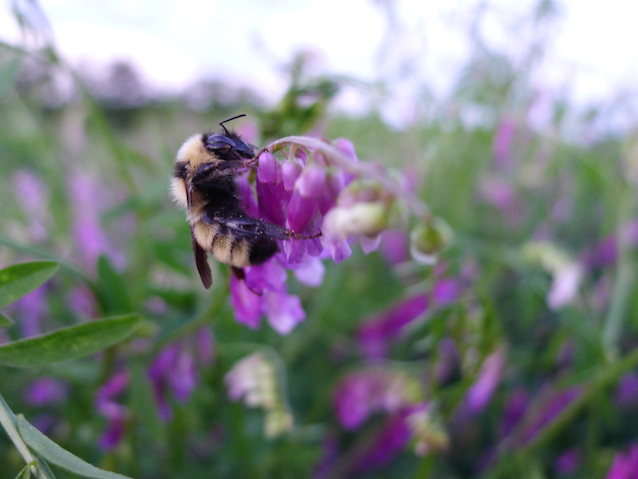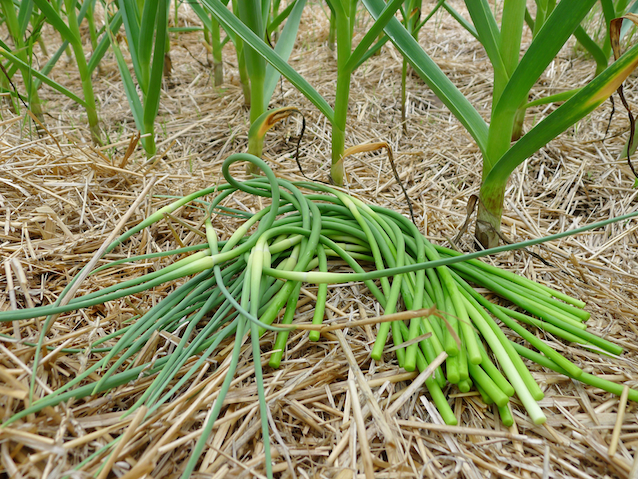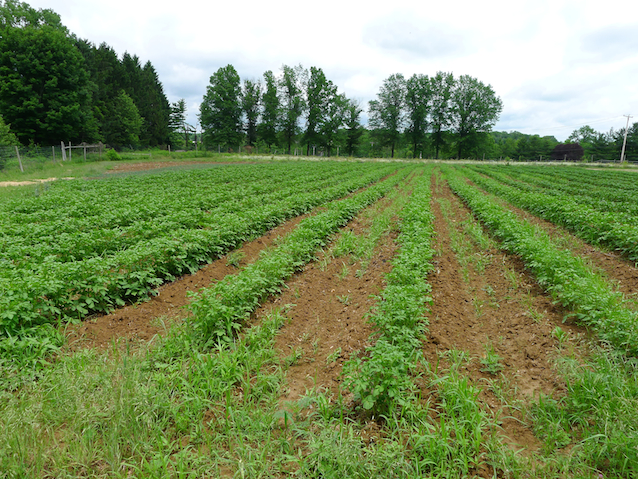
Grateful for the rain

Helpful for pollination, a bumblebee enjoys the flowers of hairy vetch, a nitrogen-fixing and organic-matter-producing cover crop plant.

A late spring treat, garlic scapes will be part of shares for a few weeks as the garlic plants attempt to flower and reproduce.
News
Notes From The Field
Benefits of Rain
By Derek McGeehan
Benefits of Rain
By Derek McGeehan
Last week the farm received its first significant rainfall in over a month, thankfully. Because the ground was so dry and hard we were especially fortunate that the rain was a slow and steady kind instead of heavy downpours. The cooler weather was also welcome but now we need the ground to dry out just enough so that I can hill the wonderful looking potatoes later today, before it rains again Monday and maybe Tuesday.

Seen from the south, these rows of potatoes desperately need to be 'hilled' to support additional underground tubers.
We're supposed to have another heat wave this week so the rain couldn't have come at a better time for the unirrigated crops, cover crops, fallow areas, and pollinator habitat. The unirrigated garlic has started to bestow upon us its first tasty treat of the season, the scape. This long and skinny shoot would eventually become the flower of the plant but gets pulled out when it is still young and tender. Besides giving us this great treat, by removing the plants' flowering mechanism, more of its energy can be spent producing larger bulbs underground for us to harvest in July. Look for scapes in your shares for a few weeks. Also new this week are scallions, a cousin to garlic scapes. These look perfect right now for distribution requiring no cleanup of outer leaves. Above ground, the unirrigated potatoes have grown by leaps and bounds since the rain and since they were cultivated a couple of weeks ago. The tubers grow underground but above the seed potato that was planted in late April. To support additional potatoes they must be hilled once or twice to allow the additional potatoes the ability to grow without greening. Hilling basically means pulling 4 disks behind the tractor that pile up the soil around the plants and only leave 6 inches of top growth exposed while covering up the lower 12 inches.
The rain really benefited the fallow area cover crops and the 2-acre pollinator habitat. To replenish the health of the soil and allow it to recuperate after years of supporting annual vegetable crops we've been attempting to rotate 3-year fallow fields around the farm. In these areas we sow a mix of self-sowing annual cover crops like buckwheat and sunflowers as well as short-lived perennial cover crops like red clover. Each cover crop flowers and attracts beneficial insects and pollinators besides improving the soil. Ideally in these areas the intentionally sown cover crops would smother unwanted grasses and weeds but it doesn't always work out that way. Instead, the majority of the species growing seems to be the ones we want but overall the patch ends up supporting a wide array of plants and bugs and it is the diversity of these areas that we hope provides the most benefit.

Expected Harvest
New: Scallions, kohlrabi, and scapes
By Derek McGeehan
New: Scallions, kohlrabi, and scapes
By Derek McGeehan
Harvest #4 (Week B) should include arugula, baby kale, scallions, mini lettuce, romaine lettuce, butterhead lettuce, bok choy, radishes, kohlrabi, basil, garlic scapes, parsley, chicory, and summer squash. Some items will be a choice. U-pick should include dill, cilantro, strawberries, snow and sugar snap peas, and perennial herbs.

2015 Workshop #1: "Now What?!" Please join us on Saturday, June 13th from 2 to 4 PM.
By Gia Yaccarino
By Gia Yaccarino
Maybe you are a new member. Maybe you've been a member for a while. Either way, this workshop is for you!
In the barn, everything made sense as you were putting your share into your bags to bring home. At home, once you began unpacking, it suddenly became very overwhelming. We have all been there.
Let us help you make the most of your farm share.
Being a member of a CSA opens the door to so many topics. We will talk about:
- Resources: books, websites, Anchor Run CSA website (Recipes and Veggies 202 it has pictures!!)
- How to keep your veggies as fresh as possible once they are in your refrigerator.
- The pros and cons of different preservation techniques (freezing, canning, dehydrating).
- Tools of the trade, which I find invaluable.
- Before you compost: radish greens are edible!
- Composting: Composting at the farm; what and what not to include in a compost pile; vermicomposting.
- Solar Cooking
Hopefully this will pique your interest for the next workshop on Sunday, June 28th Recipes Tried and True. We will share the recipes from our farm shares that our families love. And by share I mean taste and provide copies of the recipes. Pestos - don't limit yourself to basil! What to do with all that Bok Choy! Veggie Hash! The list goes on! Stay tuned for the time of this future event.

How did I enjoy my harvest this week?
By Linda Dansbury
By Linda Dansbury
It's hard to believe another week has passed and I am trying to remember how I used my delectable greens and veggies. Here is some of what I made this past week:
Broccoli raab and custom greens mix - chopped and then sauted the greens with garlic and red pepper flakes. Meanwhile, I grilled portabella mushrooms until cooked but still holding their shape. I then put a pile of the cooked greens on each mushroom and topped with a bit of parmesan cheese and then put them back on the grill just until the cheese melted. Before serving, I drizzled a nice olive oil on top - a really delicious dish!
Peas - ate a lot of them raw and very lightly steamed the rest - they only need 1.5-2 min.
Romaine Lettuce - grilled the entire head until barely charred and then made into Caesar salad
Butter head lettuce, radishes - prepared a very light salad dressing the way my grandmother did - a bit of salt, pepper and celery salt and then a light vinegar and canola oil. Lightly dressed the lettuce, made a great side for a simply grilled piece of fish.
Arugula, endive, escarole and other lettuces - various salads using a mix of greens, which I find make interesting salads. We grilled chicken and put Bar-B-Q sauce on, so it was a fairly strong tasting meal. Making a salad with robust greens and using a vinaigrette containing a bit of Dijon mustard, red wine vinegar, a good quality olive oil, gave the chicken a nice counter point.
I still have my bunch of turnips, some radishes and bok choy left - I plan to do a stir fry in the next couple of days. Please let me know how you enjoy your harvest at lindadansbury@comcast.net

Member ideas and suggestions
By Linda Dansbury
By Linda Dansbury
Thank you to the members who emailed this past week. I truly love hearing from you and so am disappointed that I inadvertently deleted an email from one of you - I am still getting used to a new phone. So, will the person that sent me the soup with the broccoli raab recipe, please forward it back to me. Although the broccoli raab season is finished now until the fall, I want to capture it because it sounded good and I really wanted to try it. I suspect that other greens, such as dandelion, would work equally well in that recipe.
I had a couple of members email me about how they have found their greens, in particular, but many veggies store the best, and they all said the same things: when you get home, wrap the greens/tender veggies in paper towels and then place in a plastic bag and store in the crisper drawer of your fridge. Marsha Rudolph passed on that she then lets the paper towels dry out and reuses them. Derek's mom, Susan, said she wrapped her CSA share in this manner, went away for 12 days and upon returning, the veggies were still in good shape!
My mom also found years ago when faced with a large amount of lettuce that if a large Tupperware type container is lined with paper towels and the lettuce placed in that, the lettuces keep for a long time. I use this method quite a bit.
If you have questions, ideas, recommendations and/or recipes please email me at lindadansbury@comcast.net. Please put Anchor Run in the subject line.

Return Pint and Quart Containers
Please return your pint and quart containers to the barn as long as they're in a usable condition. Thank you!

Beautiful strawberries and peas
By Linda Dansbury
By Linda Dansbury
If you are wondering how to make the most of the delicious strawberries and peas, read on.
For strawberries eat what you can - even check out the salad recipe with strawberries and poppyseed dressing on the farm website - it is delicious. When you get the berries home, lay them flat on a clean towel and pick through them. Eat those that are very ripe or have a blemish on them as soon as you can. Let the berries dry on your kitchen counter - wet spots on the berries creates the right environment for the berries to rot quickly. Once dry, place in an open container in the fridge - they will still only last up to about five days. Strawberries also freeze well. Cut the green tops off and place on cookie sheets and place in freezer. When frozen, they can be put into plastic bags for storage - use them in smoothies, on ice cream or even let them thaw and put on cereal.
Sugar snap and snow peas fresh out of the field are so sweet and good for you. They can be simply steamed and then garnished with a little mint or parsley for extra flavor. You can add them raw to salads; try cutting them into slivers and adding them to chicken or tuna salad or eat as a snack with hummus or your favorite dip. If you store the peas in sealed plastic bags in the fridge they will keep for about ten days, although they will become less sweet the longer they are stored. Both types of peas can be frozen, but must be blanched first. Bring a large pot of water to a full boil. Four quarts of water to three quarts of peas. While water is coming to a boil, prepare the peas by removing the strings. Add to boiling water and boil for exactly two minutes. Shock in ice cold water. Drain well, then place in freezer bags and freeze.

Many new crops
By Linda Dansbury
By Linda Dansbury
The warm weather and rain has benefited many crops, so we are seeing several new additions this week. Below is a bit of info for each one:
Baby kale - like its older "cousin" it is very good for you, but unlike the more mature version, it is more mild in flavor and needs far less cooking time. Baby kale can be stir fried or used raw in a salad. It is sturdy and when sealed in a plastic bag, it will keep for about 10 days.
Scallions - in the onion family, but much milder. Slice thin and add to salads and cooked veggies, or grill whole and then eat as is or add to a variety of dishes. I like the mild flavor and use it as an onion substitute. If you use them in a cooked dish such as a stir fry, add them toward the end of cooking time. They are fairly perishable so use within a week.
Scapes - as Derek describes, they are the flower shoot of garlic. They have a mild garlic flavor and can be used in a variety of ways - even made into pesto! Check out the website for the pesto recipe and others. If you use them to replace garlic in a cooked dish, add at the very end - long term cooking destroys the flavor. Sliced thin, they can be put in freezer bags for use later, but I have found they store for weeks in the fridge, so I have never frozen them.
Kohlrabi - this unusual looking veggie is a nice addition to salads and cole slaw when peeled and sliced thin. I end up eating them raw as a snack either lightly salted or dipped in hummus. A fellow member told me she tried to roast them last year and they came out delicious. Check out the recipes on the web site. They store well in the fridge and will keep for a couple of weeks.
Summer squash - familiar to most, so I will just mention that there are lots of recipes on the web site and Anchor Run grows many varieties, many of which may look unfamiliar. Please try them all - they have subtle differences in flavor but can all be used interchangeably. By far my favorite way to eat them is to grill them. The little ones can be grilled whole, larger ones can be sliced and drizzled with olive oil before grilling. Watch them closely because they will go from nicely carmelized to a blackened mess very quickly!
Enjoy the harvest and email me with your favorite cooking methods and recipes at lindadansbury@comcast.net


